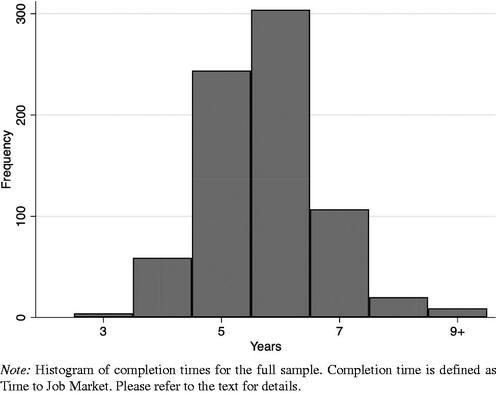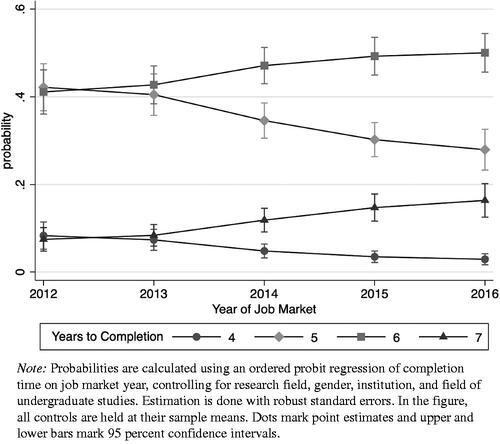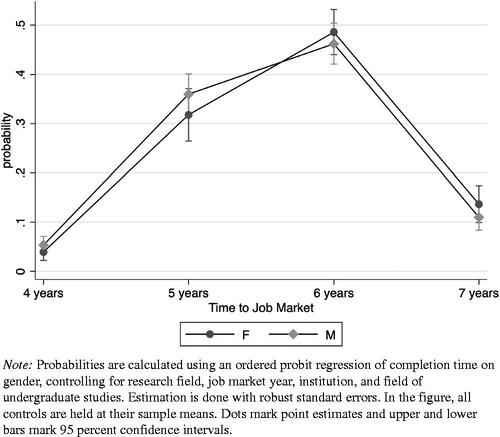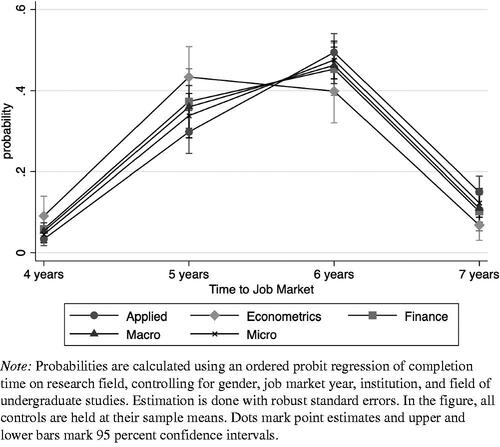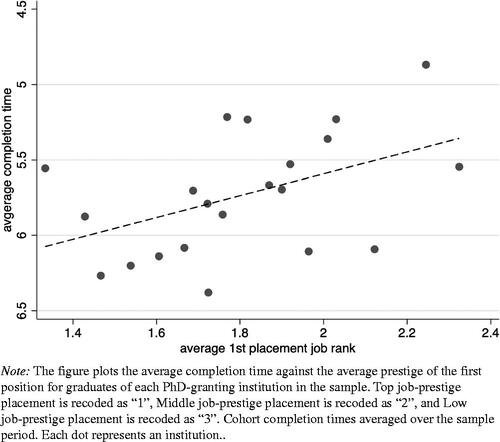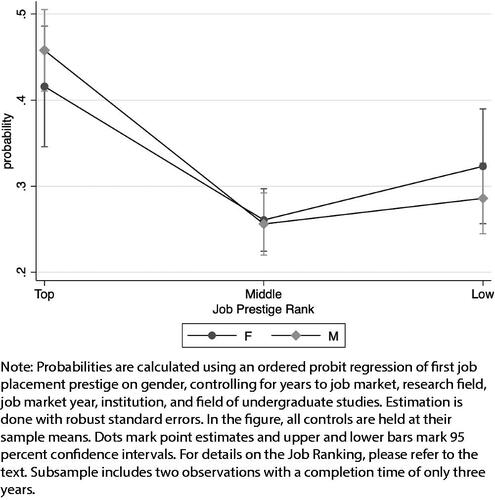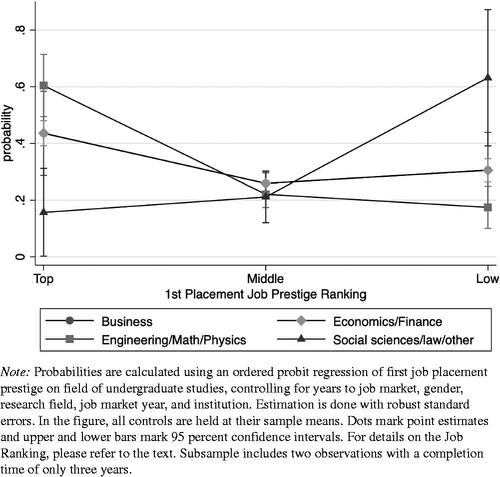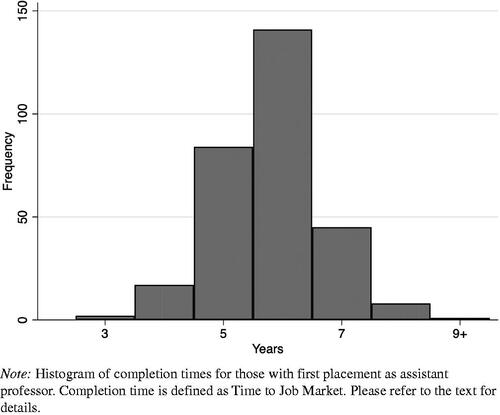Abstract
Stock, Finegan, and Siegfried establish that completion times in U.S. economics PhD programs have been on the rise, with the median steadily approaching six years. Do European programs experience the same trend? The authors of this article present new hand-collected data on job market candidates from the top European PhD programs in economics. In the past five years, completion times have been rising steadily, and the median is now approaching six years. Empirical evidence suggests that a shorter PhD duration is statistically associated with less prestigious placements. The authors further investigate how PhD duration and placement prestige vary with personal researcher characteristics such as gender or field of undergraduate studies.
Recent years have seen an increasing convergence of economics PhD programs in Europe toward their U.S. counterparts. Footnote1 Increasingly, a number of European programs offer structured programs that include a significant coursework component and are able to provide funding for the entire program length. While this convergence has been noted, little structured information is available on these European programs. We take a first step toward filling this gap.Footnote2
Using a unique hand-collected dataset, we add to the results of Stock, Finegan, and Siegfried (Citation2009) and Stock and Siegfried (Citation2014) on completion times in U.S. graduate programs in economics. We find that completion times are on the rise in European structured graduate programs, too. In the past five years, median completion times have been rising steadily, and the median is now approaching six years. We also provide some qualitative descriptions of the differences between European programs and their U.S. counterparts, in particular with regard to program structure and funding.Footnote3
Our analysis focuses on “job market candidates.” These are the students who compete in the international academic job market for economics graduates.Footnote4 We believe this to be the policy-relevant subsample for four reasons. First, delivering internationally competitive candidates is the stated goal of many European economics PhD programs. The job market is the highest international standard for young researchers in economics. Second, focusing on job market candidates ensures that the students we consider are at the same stage of their career as their U.S counterparts. Third, although we do not measure time-to-degree (TTD) directly, focusing on job market candidates allows us to generate a measure of TTD that is generally similar to that used in the literature (see, e.g., Stock, Siegfried, and Finegan [Citation2011]). Finally, over the last years, the international job market has become an important recruiting device for economics PhD graduates outside the narrowly defined academic sector. Increasingly, international organizations, such as central banks, governments, and also the private sector, are hiring through the economics job market.
We also investigate how completion time and prestige of the initial placement vary with personal researcher characteristics. For each candidate in the sample, we collect data on gender, field, field of undergraduate studies, and their initial placement. Candidates who go on the market in the sixth year of their PhD have a significantly higher probability of top-ranked initial placements. Due to data limitations, this cannot be interpreted as longer preparation times causing the increased probability of high prestige placement. Similarly, a plausible explanation would be that more able and/or ambitious students (who eventually get better jobs) spend more time preparing for the job market. However, both possibilities have the same equilibrium implication: students who take the most prestigious jobs spend around six years preparing for the job market.
In most European countries, the official governmental funding opportunities for doctoral studies are not in line with this observation. We find that field and gender do not significantly correlate with completion time or with placement prestige. We do find, however, that the probability of placing in a top-ranked institution is lower for economics PhD candidates trained in other social sciences compared to candidates trained in, for example, the natural sciences. One might interpret this finding as evidence for the importance of formal mathematical training for the successful completion of an economics PhD, but selection and preferences may get in the way of such causal interpretations.
Economics PhD programs in Europe
Selection of programs
We established a list of top European programs from a variety of sources. In particular, we emphasized that they should have international recruiting and placement, as well as a structured graduate program (including coursework), which makes them comparable to top U.S. programs in style. Several publicly available rankings aided our search for candidate programs.
Our procedure resulted in a list of 21 programs. Of these, five are located in the United Kingdom (University of Cambridge [hereafter referred to as “Cambridge”], London School of Economics and Political Science [“LSE”], University of Oxford [“Oxford”], University College London [“UCL”], University of Warwick [“Warwick”]), four in Spain (Universitat Autònoma de Barcelona [“Autonoma Barcelona”], Universidad Carlos III de Madrid [“Carlos III”], Centro de Estudios Monetarios y Financieros [“CEMFI”], Universitat Pompeu Fabra [“UPF”]), three in Germany (Universität Bonn [“Bonn”]), Göthe Universität ([“Frankfurt”]), Universität Mannheim [“Mannheim”]), two in France (Paris School of Economics [“Paris SE”], Toulouse School of Economics [“Toulouse”]), two in Italy (Bocconi University [“Bocconi”], European University Institute [“EUI”]), two in the Netherlands (Tilburg University [“Tilburg”], Tinbergen Institute [“Tinbergen”]), two in Sweden (Institute for International Economic Studies [“IIES”], Stockholm School of Economics [“SSE”]), and one in Switzerland (University of Zurich [“Zurich”]). We do not purport to establish that these are the 21 best programs in Europe, nor would we want to rank them. But the list does include all “usual suspects” for the top spots, so we would certainly expect that, for example, the top 10 programs (whichever they are) are included in this set.
Program structure
provides some information on the program structure for each of the European programs. Generally, the setup of these programs is very similar to that of U.S. programs: they consist of a coursework phase, where the first year comprises core courses and the second year consists of electives and moves students toward the research frontier. The balance between courses and initial research in the second year varies from program to program, while the first-year programs are largely standard and very similar to those in U.S. programs.
Table 1. Program details.
There is one big difference in the setup compared to U.S. programs: in many of the European programs, the coursework phase is treated as a separate degree program and leads to titles such as MPhil or MRes. Thus, in some of these programs, PhD students are just a subset of a master’s degree class for the first one or two years (for example, CEMFI), while others are entirely integrated as in a U.S.-style system (for example, EUI). Further detail is provided in .
In all programs under consideration, coursework is targeted at future PhD researchers. Why then offer this coursework for a terminal master’s degree as well? We suspect that this is largely due to the current setup and the structure of public funding for postgraduate (and in particular, doctoral) education in Europe. Following the Bologna process, the typical European student completes a three-year bachelor’s degree in his or her field of interest, followed by a one- or two-year master’s degree. Public funding (most of the programs are housed by public institutions) is often structured the same way, where it is beneficial to have class sizes above the typical number of students in a PhD program. Thus, economics departments fit the “ideal” U.S.-type program into the European system by making the coursework phase a master’s degree. In addition, some programs use this to select the best students from a large pool that undergoes initial coursework (for example, UPF). The demands that first-year coursework place on students leads to the admission of mostly (or in some cases, exclusively) students who have already completed a “regular” master’s degree elsewhere, sometimes in the same university.
One possibility that the above structure raises is that students might switch programs when they enter the research phase. We find that such switching is exceedingly rare. While it occurs that students earn a master’s degree in one of these programs and then enter another, they then typically retake the entire coursework phase of their new program. Summarizing all of this, we concluded that these two-step programs can safely be considered PhD programs with a coursework component, similar to their U.S. counterparts.
Program funding
There are large differences in funding from program to program as well. Not too dissimilar from the United States, all of these programs can, in principle, fund students through the entire length of a PhD. However, in some cases, funding is insecure from year to year or provided only in return for teaching and research assistantships. Finally, there are large differences in the availability of funding across any one cohort, with some programs providing funding to all admitted (for example, SSE) and others separating the admission decision from the funding decision entirely (for example, Cambridge and Oxford).
An important difference to fully integrated U.S. PhD programs arises in the European programs that separate their course phase into a stand-alone master’s degree. Here, the majority of the programs do not provide funding for the master’s stage. Funding is then restricted to the research phase of the PhD, following the initial one or two years of coursework.
Data collection and processing
Data collection proceeded in two stages. In the first stage, we looked up current job market candidates for each program (this was in 2015–16) and placement results of past job markets (2011–12 through 2014–15) online, whenever data were available. We searched for each candidate’s CV using personal Web sites, professional Web sites, and LinkedIn profiles. This led to some, but very limited, missing data for students who were listed as job market candidates but whose entry dates cannot be established.
We focus on candidates who enter the international “job market” at the end of their PhD. This is a subsample of all students who enter a program and typically also a subsample of the students who enter and complete a program (although, in principle, one could enter the job market without ever defending). Notably, the sample may be significantly smaller than the sample of students who obtain a degree. (We confirm this for one school, the EUI, for which we have administrative data on time-to-degree. These results are discussed in the next section.) We focus on this “job market” sample because delivering competitive candidates to this job market is the stated goal of most programs in our sample. It also increases comparability to the U.S. literature, where students typically enter that same job market (which originated and takes place in the United States) at the end of their program.
We determined each candidate’s entry year into the program. Our measure for completion time, “time to job market,” is the difference between the job market year and the entry year. We include the relevant coursework stage and the time spent on the job market. The measure is not dependent on the timing of the defense. This results in an approach that slightly differs from the U.S. literature cited in this article, which often focuses on time-to-degree (cf. Stock, Siegfried, and Finegan Citation2011). To reflect this difference, we use the term “completion time” rather than time-to-degree throughout the article.
Our approach makes our data more reliable and more comparable to U.S. data on completion times than European data from official sources would be. This is because European programs differ strongly in how they account for coursework time and time spent on the job market, as we described above. Therefore, a detail-oriented approach and knowledge of the program structure are necessary to attribute the right de facto number of years to a PhD program. In addition, students regularly enter the job market only after having completed their defense. This is different from the United States, where the defense typically follows the job market. As a result, our measure is likely to be more comparable to U.S. time-to-degree than using time-to-degree for European students.
In the second stage (in the summer of 2017), we collected job market outcomes and additional covariates per candidate. We created a job-prestige ranking depending on the job title of the first placement job. Assistant professors are coded as a top-prestige placement, post-docs are coded as a bottom-prestige placement, and other job titles are assigned to the categories top, middle, and bottom, according to our best effort.
In addition to the job quality ranking just discussed, placement institutions were coded for “prestige” as follows. Outcomes were classified into three different classes: academic, institutional, and private sector. Within each class of placements, we assigned specific institutions as a member of the top, middle or low group of institutions within that class. For academic institutions, we made use of the IDEAS/REPEC ranking of Top Economics Institutions, as of June 2017, to assign universities to groups.Footnote5 For institutional jobs, we ranked prominent international institutions such as IMF, ECB, or World Bank, and top national institutions of large countries (Fed, Banque de France, etc.) as top, less prominent international institutions as middle and national institutions of smaller countries as low. For private-sector jobs, our decision rule was based on the international reputation of the company without resorting to a formal criterion. While the IDEAS/RePEc ranking is just one of many possible academic rankings, it is easily accessible, computed based on transparent rules, and comprehensive in coverage.
While the categorization represents our best effort to capture the prestige of a job and an institution, it is clear that some nuance will get lost along the way. In particular, one might want to keep in mind that placement prestige does not equal placement quality: individual preferences for locations, jobs, and institutions may differ in important ways from what is considered “prestigious.” Thus, the resulting categorization should be interpreted with some care.
Additional covariates collected include gender, field (coded as micro, macro, applied, econometrics, or finance), fields of undergraduate studies (economics, business, natural sciences or engineering, social sciences or humanities), age, and nationality. (Data on the latter two turned out to be missing in many cases, so we did not use them for analysis). We also returned to our original sources and compared reported placements for 2016 versus the list of names that were reported to be on the market in 2015–16. This gives us a clear idea of the extent to which collecting reported past candidates is representative of actual past candidates. We discuss these results in the next section.
Sample selection and representativeness
Our attempt in this article is, in the first instance, to compare European job market candidates to their North American counterparts. The main selection issue that our method of data collection faces is whether reported past job market candidates (“placements”) correspond to actual past job market placements. Here, two issues might occur. First, candidates might be added to placement lists when they get jobs outside of the academic job market. Second, candidates who do not place well or not at all may not be reported among past placements.
As mentioned above, our two-staged data collection approach allows us to examine this issue for the 2015–16 job market. We found the former issue to be minor and therefore do not report it. The latter issue is somewhat more prevalent, although only in some programs. We report the results in . In one case (UPF), a university stopped reporting placements altogether. For a couple of programs, job market candidates were not yet listed during our first stage of data collection.
Table 2. Percentage listed.
This issue, while relevant to prospective students, is most relevant to our research setup if it influences our results on completion time significantly. It turns out that the issue is minor: those who are listed as placements took, on average, 6.05 years by our measure, while those that were not reported as placements took 5.90 years. The difference is not statistically significant.Footnote6
Another issue is missing data. For a few programs, one or several years of job market data are missing. Typically, these are recent (Cambridge, Warwick, and Zurich) or older years (UCL, UPF, Warwick), or years for which a smaller program did not deliver job market candidates (CEMFI). However, we do not believe that this influences our conclusions with regard to completion time.
Importantly, we do not claim that our sample is a representation of entering students: Some may drop out or be asked to leave at various stages. Some students may not enter the job market and therefore go unlisted on Web sites. For the EUI, we have access to administrative data on all PhDs awarded. On average, about half of the PhD recipients go on the academic job market and are publicly listed as such. For the years 2012 to 2015, the average job market candidate took a quarter of a year longer to obtain their degree than the average degree recipient. While these are interesting statistics, they do not have immediate consequences for our research question as it is concerned with those students who enter the international job market. At the same time, the small difference in average completion time suggests that our results may provide a good indication of completion times for all PhD students in our sampled universities. In addition, the fact that those students who enter the international job market spend (somewhat) more time in the PhD programs is also in line with some of our additional results that show a positive association between prestige of placement and completion time.
Results
Completion times
Our results on completion times are displayed in . Average and median completion times have been rising since 2013. Both the average () and median () are at six years for the 2016 job market cohorts. This finding is remarkably consistent across programs, with both averages and medians lying between five and seven years for all programs. We missed information for a few years for some programs (whenever the reported number of observations is zero in ), but our overall number of observations is large. We do not observe qualitative changes to our results when calculating observation-weighted averages.
Table 3. Average time to job market (years).Table Footnotea
Table 4. Median time to job market (years).Table Footnotea
Table 5. Number of observations.
To provide some further insights, presents a histogram of completion times across all programs for the last two years in our sample. Completion times are rather concentrated around six years. While five and seven years of completion time also occur frequently, almost no students finish in four years or less.
Covariates of completion times
We report results from an ordered probit model regressing Time to Job Market (completion time) on Year of Job Market (a trend variable), Field of Economics, Gender, PhD Institution, and Field of Undergraduate Studies, estimated with robust standard errors. We consider completion times longer than eight years to be outliers and remove such observations. For each covariate presented (in the figures we refer to), we report the probability of observing a certain Time to Job Market for each level of the covariates, holding all other covariates at their respective sample means. The confidence intervals shown are 95 percent confidence intervals. , column 1, contains the estimates of our ordered probit model.
Table 6. Regression table.
The predicted probabilities of observing particular completion times for each year of the sample are shown in . This confirms the raw completion times results reported in and . Completion in six years becomes significantly more likely than completion in five years over the sample period, which is not yet the case in the early sample years. The same is true when comparing completion in seven years to completion in four years. Going on the job market in the 4th year of the PhD, which still occurs with some probability in 2012 and 2013, becomes increasingly unlikely toward the end of the sample.
shows that the predicted completion times of female candidates are slightly longer than those of their male counterparts; however, the differences are not statistically significant. shows that the same is true for PhD candidates in different subfields of economics, although, interestingly, students working in econometrics seem to take less time to enter the job market, everything else equal.Footnote7
Covariates of placement prestige
We estimate a similar model to that of completion time, this time using our placement prestige index as the dependent variable, pooled over all classes of placement. In addition to the covariates reported for completion time, we also include Time to Job Market as an additional explanatory variable. An important qualification to stress is that this does not allow us to infer any causal link from completion time to placement prestige and that the reported association is purely statistical in nature. The results reported are obtained in the same way as in the previous subsection. , column 2, contains the estimates.
shows the probabilities of placing in a top-, middle- or low-ranked job within the sample graduating in four, five, six, seven, or eight years.Footnote8 While for a duration of four or five years, low and high placement prestige are statistically equally likely, going on the job market after six years is associated with a significantly higher probability of placing in a top-ranked job relative to a middle- or low-ranked one. This effect attenuates again for graduates with a duration above six years. plots the average completion time and placement prestige for graduates of each PhD-granting institution in the sample. Here we convert the categorical placement prestige variable into a numerical one by assigning the values 1, 2, and 3 to the Top, Middle, and Low categories, respectively. As is apparent from the figure, average completion time and average placement prestige are associated positively in the sample. While, as already mentioned above, this does not suggest that longer completion times are causing more prestigious placement, it is a clear indicator that candidates who take a high prestige placement do take additional time to go on the job market. Because placing their candidates well is the stated goal of the departments in our sample, this has implications for the desired funding structure of their PhD programs.
shows that gender does not vary significantly with placement prestige. Because comparing placement prestige by subfield of economics is not particularly meaningful, we instead report placement prestige by the undergraduate background of PhD candidates in . Here, candidates with a social science or humanities background stand out: they place significantly worse than all backgrounds except business. The reverse is true for those with an undergraduate background in the natural sciences. One might interpret this finding as evidence for the importance of formal mathematical training for the successful completion of an economics PhD, but selection and preferences may get in the way of such causal interpretations.
Assistant professor subsample
Since the primary goal of many PhD programs is preparing candidates for a career in academia, we present some additional results on the subsample of candidates with a first placement job title as “Assistant Professor.” They represent 39 percent of the full sample.
Sample frequencies for the completion times of this subsample are presented in . The relative frequency of six vs. five years of completion times is skewed in favor of six years, with 47 vs 28 percent. This compares to relative frequencies of 41 vs. 33 percent of the entire sample.
Assistant professors all have the same job title and hence the same placement rank. We can, however, analyze the differences in prestige of the institutions that hired them. shows that placing at a top-ranked university is unlikely for all durations, but point estimates are slightly increasing with a duration from five to seven years to completion.Footnote9 Top placement probability does not increase significantly across subsamples of different duration. However, when plotting each institution’s average placement prestige and average completion times for the assistant professor subsample, there is again a positive correlation. This relationship is plotted in . As before, we convert the categorical institutional prestige variable into a numerical one by assigning the values 1, 2, and 3 to the Top, Middle, and Low categories, respectively.Footnote10
Figure 10. Predicted first placement institutional prestige by completion time—assistant professors.
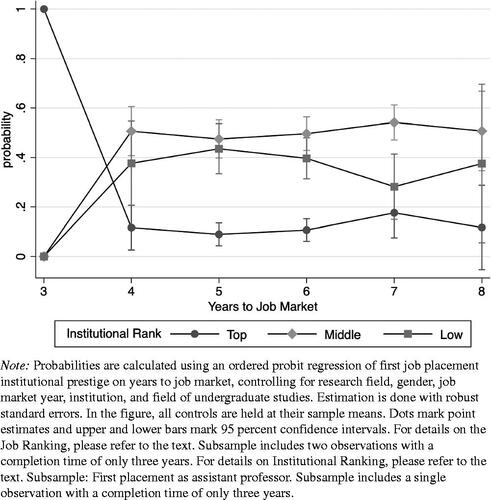
Figure 11. Placement institutional prestige and completion times across Europe—assistant professors.
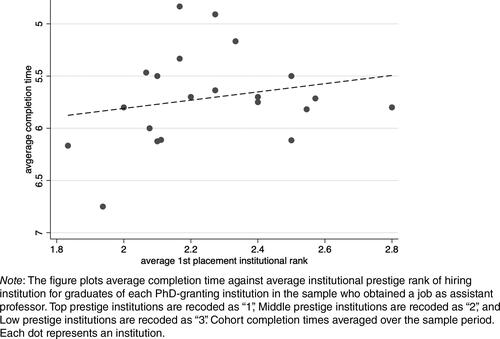
Taken together, the results of the subsample of “Assistant Professors” confirm the impression of the full sample analysis: while the results and estimates presented do not allow for causal interpretation, statistically, completion times and placement prestige are positively related. , columns 3 and 4, contains the estimates of the ordered probit models for this subsample.
Conclusion
Recent years have seen an increasing convergence of economics PhD programs in Europe to their U.S. counterparts. Completion times in the top programs have steadily risen and now reach a median of six years. This brings them rather close to the completion times in U.S. programs, as surveyed several years earlier by Stock, Finegan, and Siegfried (Citation2009) and Stock and Siegfried (Citation2014). However, program and funding structures remain different due to institutional factors. Our findings may therefore be of relevance to funding authorities and administrators.
Our results suggest that higher placement prestige is statistically associated with longer completion times. In addition, we uncover a number of facts relating completion times and placement prestige to personal researcher characteristics. The data do not show evidence of systematic differences by gender in either the duration or the placement prestige of European economics PhD programs. On the other hand, undergraduate background turns out to be a significant predictor of success in an economics PhD program if measured by initial placement prestige.
The descriptive nature of our data does not allow the identification of the causes of increased completion times. Given that limitation, we refrain from suggesting any normative implications of our findings. Nevertheless, we expect our findings to be relevant for those training and hiring young economists as they may benefit from data on the European peer group. They also may be relevant to decision-makers who define the parameters of graduate programs and set funding structures: our findings provide a few descriptive statistics that may help them to evaluate the consequences of different funding choices.
Correction Statement
This article has been republished with minor changes. These changes do not impact the academic content of the article.
Acknowledgment
The authors thank Matic Petricek for outstanding research assistance.
Notes
1 The opinions in this article are those of the authors and do not necessarily reflect the views of the German Federal Ministry for Economic Affairs and Climate Action.
2 This project started as an internal project at the European University Institute (EUI) during the period when all three authors were affiliated with the EUI. The objective was to understand the differences between the EUI Economics Doctoral Program and its closest competitors, in particular with regard to completion time. While such information was readily available for U.S. programs, we had to hand-collect information on European programs by going through the CVs of over 700 recent job market candidates. Subsequently, we realized that our findings could benefit the economics community at large, and therefore merit wider dissemination. The data are available from the authors upon request.
3 Because our analysis focuses on a subset of all European programs, with emphasis on including programs that resemble top U.S. programs in structure, our results should not be taken as representative of European economics PhD education more broadly.
4 For more information on the “economics job market,” visit https://www.econjobmarket.org/index.php. The organization describes itself as a “non-profit clearinghouse for applications to PhD level jobs in economics.”
5 The current ranking can be accessed via https://ideas.repec.org/top/top.inst.all.html. The ranking is updated continuously, so the current rankings might differ from the ones we used for our analysis.
6 The p-value associated with a two-tailed t-test for no difference in sample means, assuming unequal variance, is 0.53.
7 We also looked at the representation of women across fields. Female candidates are overrepresented in applied economics and underrepresented in econometrics. Consequently, we added interaction terms between gender and field to our ordered probit model for completion times. The resulting coefficients are not significantly different from zero. Finally, we added interaction terms between gender and institution. Except for two institutions, these are not significant either.
8 Few candidates complete their PhD in three years, which makes interpretation of the estimated probabilities for those subsamples difficult.
9 Few candidates place as assistant professors after a completing their PhD in four or less years, which makes interpretation of the estimated probabilities for those subsamples difficult.
10 For the full sample, including a quadratic term on completion time shows a diminishing relationship where longer completion times stop improving placement prestige around 6.4 years. For the assistant professor subsample, the quadratic relationship is convex, flat for completion times up to 5.5 years, and then a steeper effect of completion time on placement prestige.
References
- Stock, W. A., T. A. Finegan, and J. J. Siegfried. 2009. Completing an economics PhD in five years. American Economic Review 99 (2): 624–29. doi: 10.1257/aer.99.2.624.
- Stock, W. A., and J. J. Siegfried. 2014. Fifteen years of research on graduate education in economics: What have we learned? Journal of Economic Education 45 (4): 287–303. doi: 10.1080/00220485.2014.942410.
- Stock, W. A., J. J. Siegfried, and T. A. Finegan. 2011. Completion rates and time-to-degree in economics PhD programs (with comments by David Colander, N. Gregory Mankiw, Melissa P. McInerney, and M. Poterba). American Economic Review 101 (3): 176–88. doi: 10.1257/aer.101.3.176.

